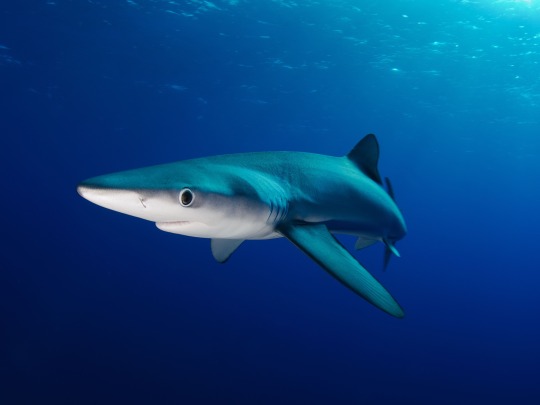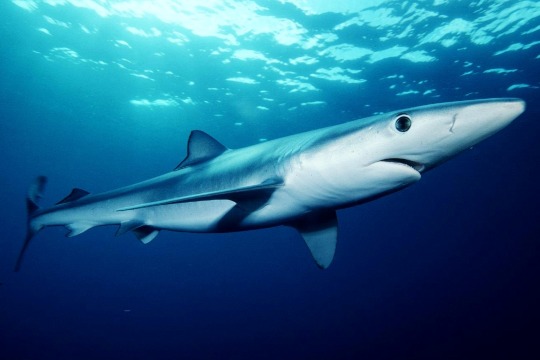#interdorsal
Text
Thinking about blacktip sharks
5 notes
·
View notes
Text

Facts of the spinner shark
***
The spinner shark is a species of requiem shark, in the family Carcharhinidae, named for the spinning leaps it makes as a part of its feeding strategy. This species occurs in tropical and warm temperate waters worldwide, except for in the eastern Pacific Ocean.
• Spinner sharks are a fast-swimming species of shark which often jumps out of the water (hence the name!). The reason for their “spinning” or spiral motion is the way in which they catch their prey. Climbing quickly within a shoal of fish, they snap on all sides while turning. Then they leap through the water’s surface, making no attempt to slow down before reaching the top.
• Spinner sharks are large and slender and have a pointed snout. The first dorsal fin is relatively small and begins at the same height as the end of the pectoral fin or slightly behind it. Spinner sharks have no interdorsal ridge.
• Their back is gray-bronze and their belly is white, and they have a thin white band along their flanks. Very noticeable are the black tips on both dorsal fins, pectoral and anal fins, as well as the lower lobus of the tail fin. Individuals smaller than 70 cm have no dark markings.
• Spinner sharks have a wide range and make seasonal migrations. They are found almost worldwide over the continental shelf, preferring shallow waters (less than 30 meters), but have also been seen in depths of approximately 75 meters.
• Their average length is approximately 195 cm at a weight of 56 kg. The longest spinner shark found to date measured 278 cm.
• They feed mainly on fish, preferring swarm fish such as sardines or herring. However, their food spectrum is very wide and also include tuna, grunt fish, lizard fish, etc., as well as mollusks, small sharks and rays.
• Spinner sharks are viviparous and have a yolk sac placenta. They bear between 3 and 15 pups which measure between 60 and 75 cm at birth. Their gestation period is 12 to 15 months and the time of birth varies depending on the location: the summer months for animals in Senegal, Spring and early Summer in Florida and the Gulf of Mexico. The young pups are born in coastal regions and grow quickly.
• The spinner shark resembles several other shark species which are mostly only identifiable by specialists. The striking black coloring of the anal fins is, however, one clear characteristic recognizable in larger animals. This species is usually mistaken for the blacktip shark (Carcharhinus limbatus) which, however, contrary to the spinner sharks has a white anal fin with no black tip.
• There have been no reports on accidents with spinner sharks.
• Spinner sharks are named for their habit of leaping out of the water and rotating up to three times in the air before falling back into the water.
• Spinner sharks hunt schools of small fish by swimming upward through the bait ball with their mouths open wide, all while spinning.
• Spinner sharks can leap up to 20 feet (6.1 m) in the air.
• Spinner sharks reach a maximum length of 9.1 feet (2.7 m)
• Spinner sharks live in shallow water and can be found anywhere from 0 to 328 feet (0-100 m) deep.
***
@sharkdefenderactivist
#my sharks#hammerhead shark#great white shark#spinner sharks#facts about sharks#shark facts#shark defender#sharkbait#shark talks#swimming with sharks#shark lover#shark rights#sharks
7 notes
·
View notes
Photo

Sandbar shark (Carcharhinus plumbeus)
True to its nickname indeed.
Distinguishable by its very high first dorsal fin and interdorsal ridge, its one of the biggest costal sharks in the world, having its dorsal fin being triangular and very high, while also having very long pectoral fins, a heavy-set body and a rounded snout that is shorter than the average shark’s snout.
Sandbar sharks can be found in tropical to temperate waters worldwide; ranging from Massachusetts to Brazil.
The sandbar shark’s diet includes fish, rays, and crabs.
Sandbar sharks are classified as vulnerable by the IUCN.
Despite their large size and having similar appearance to other dangerous sharks like the bull shark, they considered one of the safest sharks to swim with and are also one of the most popular sharks for public aquariums.
2 notes
·
View notes
Photo

A new deep-water dogfish shark has been discovered!!! named Squalus hawaiiensis, also known as the Hawaiian spurdog, this dogfish was believe to be pretty similar to shortspine spurdog (S. mitsukurii) but subsequent analysis discovered a difference in dorsal fin size and interdorsal length, in addition to genetic differences. The Hawaiian spurdong is apparently endemic to the Hawaiian Archipelago.
Dogfish sharks are biologically difficult to physically tell apart, since they are adapted to deep-sea environment, they share physical adaptation to these ecosystems. This can lead to confusion at the time of classifying them.
Reference: Daly-Engel et al., 2018. Description of a new deep-water dogfish shark from Hawaii, with comments on the Squalus mitsukurii species complex in the West Pacific. ZooKeys.
#Squalus mitsukurii#Squalus hawaiiensis#Squalus#sharks#elasmobranchs#new species#science#marine biology#biology#deep sea#pacific ocean
76 notes
·
View notes
Text
Blue Shark - Prionace glauca


First of all, I like his face.
Secondly- This carcharhiniformes shark has a noticeable dark blue-black coloration on it’s back, light blue flanks, and a white underbelly. “It is a slim, graceful shark with a long, conical snout, large eyes, and long, narrow scythe-shaped pectoral fins well in front of the first dorsal win with no interdorsal ridge.” They can reach a maximum length of approximately 12 feet. This shark is located worldwide in temperate and tropical oceans. They feed on relatively small prey, such as squid and pelagic fish, but also invertebrates, bottom-dwelling fish, smaller sharks, or even seabirds.
All information comes from [here]. Images are not mine.
0 notes